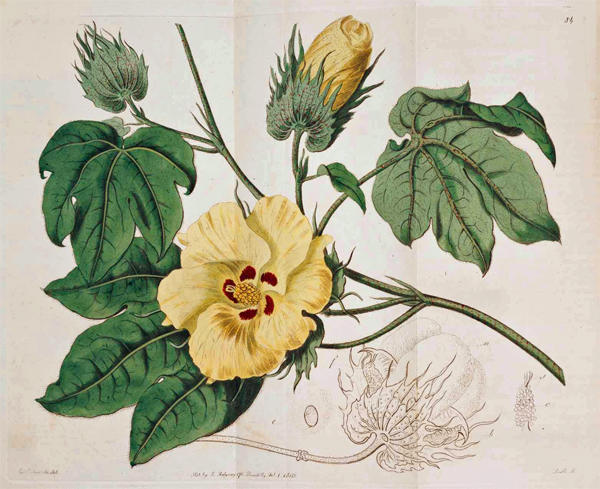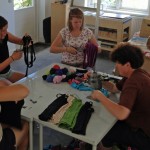In doing Action Weaving, and now Galaxy, a lot of T-shirts have passed through my…
What Price T-shirts?
Am still on the subject of T-shirts. My daily had an interesting article telling me who profits from making and selling shirts. “If we pay 29 Euro for a T-shirt (they wish), what percentage of that goes to the cotton farmer? And the seamstress? “The article is by Lidwien Dober and Fleur de Weerd an published in Trouw on Saturday October 26th (my translation).
The cotton farmer What does a cotton farmer earn? They don’t earn wages per se. In cotton, there are two kinds of businesses: the large-scale cotton farms, like in the US, Australia and Brazil. China also produces a lot of cotton, but mainly for internal use. Then there are the family businesses in Asia, mainly in India and Pakistan, some in Latin America, and many in West-African countries. Nobody considers Africa when thinking about T-shirts, and that’s because all of their cotton goes to Asia to be processed. On a typical small cotton farm five to eight people work, often family. These farms are between 0,5 and 8 hectares. Yield per hectare is around 800 kg. The end product of the cotton farmer is called seed-cotton: cotton with bits and pieces of the cotton plant still in it. One kilo nets the farmer between 33 and 53 cents. We think they need at least 56 cents. Mind you: this is not net income, all production costs have to be subtracted from it. To make a T-shirt we need just a bit over 1 kg of seed-cotton. To clear the bits and pieces from the cotton is expensive. Small farmers cannot afford to do this, so they sell their seed-cotton to big cotton-carding factories. This factory is between them and the world market, and makes it difficult for the small farmers to get a fair price. Rich countries subsidize their cotton farmers. If these subsidies would not exist, the small farmers would get better prices for their cotton – and our T-shirts would be more expensive one would think. But a lot of T-shirts aren’t made of cotton only: there is polyester spun in. If the cotton price goes up, more polyester will be added. This is cheap. The existence of a cheap alternative thus causes a fixed ceiling for cotton prices.
Damien Sanfilipo, cotton expert at Fair Trade International
 Wiki: Gossypium is the cotton genus. It belongs to the tribe Gossypieae, in the mallow family, Malvaceae, native to the tropical and subtropical regions from both the Old and New World. The genus Gossypium comprises around 50 species, making it the largest in species number in the tribe Gossypioieae. New species continue to be discovered. The name of the genus is derived from the Arabic word goz, which refers to a soft substance.
Wiki: Gossypium is the cotton genus. It belongs to the tribe Gossypieae, in the mallow family, Malvaceae, native to the tropical and subtropical regions from both the Old and New World. The genus Gossypium comprises around 50 species, making it the largest in species number in the tribe Gossypioieae. New species continue to be discovered. The name of the genus is derived from the Arabic word goz, which refers to a soft substance.
The seamstress “To spin cotton, to weave or knit with it – a T-shirt is knitted – separate factories exist, but this often happens in the industrial area where the sweatshops are located. The knitting is – in the main – automated, but the few people that are needed work in a noisy and dusty environment. They earn twice the salary that a seamstress takes home, mainly because they are men. And men earn more. One of the lowest-wage workers in a sweatshop is the helper who stands next to the seamstress, hands her thread and passes on cloth. This nets the assistant 3000 taka per month, a little under 30 Euro. A seamstress earns a little more. Last year, we calculated the amount of money a seamstress in India earns for sewing a T-shirt that costs 29 Euro in the Netherlands. The sum totals at 18 cents. Even so, wages in India are a little higher than those in Bangladesh. In the latter country negotiations are taking place about wages in sweatshops. Unions want 8000 Take (a little over 75 Euro) per month, that isn’t enough to get by on. The lowest-wage manager in an office earns ten times as much as a seamstress. We don’t know how much factory owners earn. We think the operating margin for a factory is around 4 percent. The factory owner gets paid only after delivery of his wares in the harbor of Cittagong. And all factories are in the capital, Dhaka. The road between capital and harbor is so bad that a cargo truck with container cannot make use of it. So all transport is done via pickup trucks, with tarps protecting the cargo against all weather. The ride of about 250 km takes 10 hours. When it rains, goods are often damaged. Compensation for this comes out of the operating margin.
Sophie Koers, Head of Communication Fair Wear Foundation, where producers, unions and ngo’s work together for better working conditions.
The commissioning company “Sometimes it is a brand name that places a T-shirt order. H&M and C&A have their own contacts with factory owners worldwide and place their orders without intermediaries. But a lot of T-shirts are ordered by traders that look for customers afterwards.”How much does a brand name – principal and seller – or a trader earn per shirt? “Unfortunately we cannot give out information about our pricing strategy”, C&A let us know. Why not? “We don’t share cost prices with third parties.” “Those in the know, please step forward” says Jef Wintermans, director of fashion-retailers organisation Modint. “These days, the question might be: what profit margin? Making loss is an endemic problem in the fashion sector – the large number of shops closing doesn’t indicate any great profit. Also, the enormous variation in the way companies are structured doesn’t allow for a clear-cut answer here.” Fair Wear Foundation – industry, unions and ngo’s working together – does venture a percentage: 12 percent for the brand name, 59 for the shopkeeper. For a shirt costing 29 Euro this comes down to 3,60 and 17 Euro respectively.
The shop assistant “Shop assistants in fashion stores earn minimum wage or just a little over. For a 23-year old, this is 66,20 Euro per day. This is before taxes, what she actually gets to take home is two-thirds of this. I can’t predict how many T-shirts a single assistant would sell on any given day. That depends on the type of store she works for. The type of store does not influence her pay. Working at H&M or selling high-end womans- and menswear in a store where service and know-how are valued – the earnings are the same. Many shop assistants work part time. We’ve managed to banish the zero-hours contract, but contracts for 20 to 25 hours are common. When working those hours, one earns between 750 and 900 Euro (before taxes) per month. Some employees don’t mind, they see the work as a side occupation. But a lot of people want to work more hours. They don’t get the hours because their employer wants flexibility and the ability to have personnel work during peak shopping time. In fashion retail, it is not unusual to have two jobs. Until the year 2008 we had collective agreements negotiated with the Fashion Retailers Union. This union numbers brand names like C&A, We, Miss Etam and Perry Sport among its members. We haven’t been able to agree on general terms of employment ever since. And yes, that is telling – but I cannot force them to come to the table. Under employees there is little willingness to take risks. Not because they are afraid of their bosses, but because they are just so involved with their customers. What would customers think if the shop closes because the shop assistants go on strike? Fashion personnel are very service oriented. And have been for the last hundred years. Three years ago – the last collective agreement had already expired – lowest wages in the shops suddenly plunged under minimum wage. The Minister for Social Affairs wrote the retailers a letter, telling them this was against the law. They have been complying with legal regulations ever since. Last September we tried to open up negotiations again, but we are getting nowhere. We think about giving up trying.”
Ron Peters, union foreman retail at FNV Bondgenoten
The transport firm “We never deal with one T-shirt as a unit, we talk about boxes. One box holds 6 dozen T-shirts, a total of 72. Most T-shirts are imported from Bangladesh. A number come from Mexico, Honduras and Haiti. All low-wages countries. Sometimes the shirts are white, sometimes they are printed in the country of origin. Boxes with shirts go from the factory to the harbor. I don’t know the exact cost of this transport, but it isn’t much. At the harbor, people stand ready to stack the boxes in a sea container. Which is time consuming. It is less work to stack the boxes on pallets then move them to the container, but that way we can’t fit as many boxes in one container. Wages in Bangladesh are low enough to make it more economical to fill a container by hand. One container fits 1400 boxes, that is more than 100.000 T-shirts. Two of our people are in Rotterdam harbor, ready to unload the container: they put the boxes on pallets and seal them, ready for transport to the storage facility. This takes 2, 5 hrs in all; these men process more than one container a day. Transport from Bangladesh to Europe costs 3650 Dollar (2685 Euro) per container, that is an average of 3 cents per shirt. Additionally there is import duties to be paid. Imports from certain third-world countries are exempted. The total purchase price per dozen shirts is somewhere in the region of 7 to 12 dollar, so less than a dollar per shirt. We know because we declare the goods to Customs when they come in. Those 7 to 12 dollar is what the traders – they account for the largest number of T-shirts imported – have paid the moment the shirts enter Europe. Transport by truck from Rotterdam to the storage facility costs between 100 and 200 Euro, depending on where the storage facility is situated. That covers the wages of the truck driver, the drive itself and teh costs of our logistics department that manages it all.”
Charley Dietvorst, director of international transport company VAT logistics. VAT has subsidiaries in the Netherlands, Finland, Italy, Russia and China
| « Piece for two hands | <-- previous post | next post --> | Brainstorm » |
|---|







